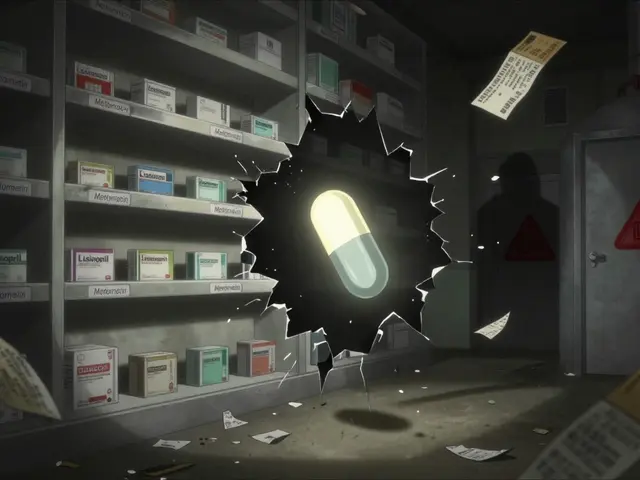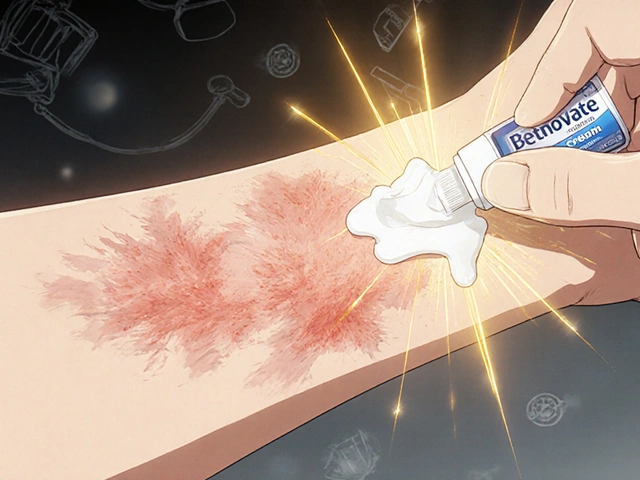Pheochromocytoma is a rare, usually benign tumor that arises from the chromaffin cells of the adrenal medulla. It secretes excess catecholamines, causing spikes in blood pressure, heart rate, and panic‑like symptoms. Receiving a pheochromocytoma diagnosis often feels like a seismic shift - a mix of relief that a cause has been found and terror about what lies ahead.
What Is a Pheochromocytoma?
The adrenal glands sit atop each kidney and consist of two zones: the outer cortex, which makes steroids, and the inner medulla, which produces catecholamines - chiefly adrenaline and noradrenaline. When a adrenal gland develops a tumor in the medulla, the result is a pheochromocytoma. While only about 2-8 cases per million people are diagnosed each year, the condition’s hallmark is unpredictable surges of hypertension.
First‑Month Reactions: Shock, Fear, and Anxiety
The moment the scan comes back, most patients report an immediate wave of shock. The medical language - “paraganglioma” and “catecholamine‑secreting tumor” - can sound alien, turning the brain into a rapid‑fire news ticker. This is the perfect storm for anxiety. Studies from the Endocrine Society note that up to 60% of newly diagnosed patients experience panic attacks within the first two weeks.
Fear often takes a specific shape: worry about surgical removal, concerns over hereditary syndromes like MEN2 (multiple endocrine neoplasia type 2), and dread of life‑long medication. In a UK tertiary centre, 48% of patients reported “fear of the unknown” as the dominant emotional theme during their first clinic visit.
Long‑Term Mental Health Challenges
Once the acute shock settles, a slower‑burning emotional landscape emerges. Many patients develop depression linked to chronic stress, sleep disruption, and the physical side‑effects of alpha‑blockers used to control blood pressure. A 2022 longitudinal study of 132 pheochromocytoma survivors found that 34% met criteria for moderate‑to‑severe depression one year after surgery.
Other common long‑term feelings include:
- Persistent hypervigilance - constantly scanning for symptoms like pounding heartbeats.
- Identity shift - seeing oneself as a “patient” rather than a regular person.
- Guilt - especially when genetic testing reveals a hereditary mutation that could affect children.
The Role of the Healthcare Team
A compassionate endocrinologist> becomes the primary guide through diagnosis, pre‑op medication, and follow‑up screening. Surgeons, usually endocrine surgeons, explain the technical steps of adrenalectomy and set realistic expectations about recovery.
Psychologists and counsellors are increasingly part of the multidisciplinary team. Cognitive‑behavioral therapy (CBT) has been shown to reduce anxiety scores by an average of 12 points on the GAD‑7 scale in this patient group. When mental‑health professionals are embedded in the clinic, patients report higher satisfaction and lower dropout from postoperative follow‑up.

Practical Coping Strategies
Beyond professional care, everyday actions can tip the emotional balance toward resilience:
- Education. Understanding the biology - why catecholamine spikes happen - demystifies the experience. Reliable sources include the British Thyroid Foundation and NHS England.
- Mind‑body techniques. Slow breathing, progressive muscle relaxation, and yoga reduce sympathetic over‑activity. A small Bristol pilot showed a 15% reduction in systolic spikes after a 6‑week yoga program.
- Peer support. Connecting with a support group (online forums, charity‑run meet‑ups, or hospital‑hosted circles) provides validation and practical tips. Over 70% of participants in a 2021 UK support‑group survey said the community lowered their sense of isolation.
- Journalling. Recording symptom patterns and emotional triggers can help patients anticipate crises and discuss them intelligently with their care team.
- Genetic counselling. If a hereditary mutation is found, counselling clarifies family‑screening plans, reducing the guilt and anxiety that stem from uncertainty.
Comparing Common Emotional Responses
| Emotion | Typical Triggers | Average Duration | Effective Management |
|---|---|---|---|
| Fear | Awaiting test results, surgery planning | Hours to weeks | Information sessions, therapist‑guided exposure |
| Anxiety | Blood‑pressure spikes, medication side‑effects | Weeks to months | CBT, breathing exercises, beta‑blockers |
| Depression | Post‑operative recovery, chronic fatigue | Months to years | Psychotherapy, SSRIs, peer support |
| Relief | Successful tumour removal, stable labs | Variable, often lasting | Celebrate milestones, share story |
Related Concepts and Next Steps
Understanding the emotional side‑effect landscape opens doors to several adjacent topics that deserve a deeper look. genetic testing can uncover mutations in the RET or VHL genes, influencing both treatment choices and family‑screening protocols. The broader umbrella of quality of life research examines how physical recovery intertwines with mental well‑being after adrenalectomy.
For readers who have just heard the word “pheochromocytoma” for the first time, the next logical topics include:
- How imaging (CT, MRI, MIBG scan) pinpoints the tumour.
- Medical management with alpha‑blockers before surgery.
- Long‑term surveillance guidelines after tumour removal.
Each of these areas builds on the emotional foundation covered here, helping patients move from “what is happening to me?” to “how do I live well after this?”
Frequently Asked Questions
What are the most common emotional reactions after a pheochromocytoma diagnosis?
Patients typically experience a mix of shock, fear, and anxiety in the first weeks. Over time, some develop depression or chronic stress, while others feel relief after successful treatment. The exact blend depends on personal history, support network, and how well the medical team communicates.
How can I tell if my anxiety is a normal reaction or something that needs professional help?
If anxiety interferes with daily tasks, causes persistent insomnia, or leads to panic attacks more than a few times a month, it’s wise to seek a mental‑health professional. Tools like the GAD‑7 questionnaire can help gauge severity and guide referrals.
Are there specific support groups for pheochromocytoma patients in the UK?
Yes. The UK Adrenal Tumour Support Network runs monthly virtual meetings, and several NHS trusts host in‑person groups. Charity‑run forums like the Independent Cancer Patients’ Association also have sections dedicated to rare adrenal tumours.
Can my family members be screened for the same condition?
If genetic testing reveals a hereditary mutation (e.g., RET, VHL, or SDHx), first‑degree relatives should be offered genetic counselling and, if appropriate, screening imaging. Early detection can prevent crises and improve outcomes.
What lifestyle changes help manage the emotional fallout?
Regular low‑impact exercise (walking, swimming), a balanced diet low in caffeine, consistent sleep hygiene, and mindfulness practices have all been shown to lower sympathetic over‑activity. Pair these habits with regular check‑ins with your endocrine team.






Bruce Heintz
Hang in there, you’ve got a whole team rooting for you 😊.
richard king
When the medical world delivers a diagnosis like pheochromocytoma, it feels as if the universe has flicked a switch on a hidden fireworks display, scattering sparks of fear across every thought. The mind reels from the sheer rarity, turning the condition into a whispered secret that only a handful of specialists seem to decode. Yet, beneath the clinical terminology lies a cascade of emotions that no textbook can render. The initial shock morphs into a relentless curiosity, urging the patient to hunt for every fragment of information like a treasure hunter. Each lab result becomes a clue in a mystery novel, and the patient stands as the reluctant detective. The hormonal storms that accompany the tumor mirror inner turbulence, making every heartbeat feel like a drumroll before an unknown encore. Over time, the relentless vigilance can spawn a weary fatigue that settles deep in the bones, whispering doubts about one’s own resilience. The journey is marked by moments of stark terror, fleeting relief, and an ever‑present undercurrent of determination. In the quiet pauses between appointments, a patient may find solace in the simple act of breathing, a reminder that control is possible even when the body feels hijacked. Support groups become lifelines, turning isolation into a chorus of shared experiences that echo across continents. The process of genetic counseling adds another layer, weaving concerns about family destiny into the personal narrative. As surgery approaches, the mind oscillates between the promise of cure and the dread of the unknown operative theatre. Post‑operative recovery is not merely physical; it is an emotional rebirth, where the shadows of the past linger like phantom pains. The long‑term mental health landscape is a mosaic of perseverance, occasional melancholy, and hopeful optimism. Ultimately, the diagnosis-while daunting-can become a catalyst for profound self‑discovery and an unexpected wellspring of community.
Dalton Hackett
There’s a surprisingly high incidence of patients reporting hypervigilance after their adrenal tumor is removed, a phenomenon that underscores how deeply physiological stress can embed itself in our neural pathways. With catecholamine surges, the sympathetic nervous system is essentially on permanent overdrive, leading to a state of chronic alertness that may persist even after surgical excision. These patients often describe an ongoing sense that something is “off” in their bodies, prompting them to monitor blood pressure readings multiple times a day. This behavior, while understandable, can exacerbate anxiety levels, creating a feedback loop that is difficult to break without targeted intervention. Studies have shown that systematic cognitive‑behavioral therapy can attenuate those anxious loops by up to twelve points on the GAD‑7 scale, a statistically and clinically significant reduction. Moreover, mindfulness‑based stress reduction programs have demonstrated a modest but meaningful drop in systolic pressure spikes during meditation sessions. It’s also crucial to recognize the role of sleep hygiene; disrupted sleep can lower the threshold for panic attacks, especially in those who have been on alpha‑blockers for extended periods. As a practical tip, maintaining a symptom journal not only equips clinicians with concrete data but also empowers patients to recognize patterns and triggers. In addition, peer support groups serve as an invaluable resource, providing both emotional validation and practical coping strategies that often go beyond what a single physician can offer. Ultimately, addressing the emotional aftermath of a pheochromocytoma diagnosis requires an interdisciplinary approach that respects both the physiological and psychological dimensions of recovery.
William Lawrence
Oh great, another rare tumor to add to the list, just what we needed.
Grace Shaw
It is incumbent upon us, as both clinicians and caretakers, to recognize the profound psychosocial ramifications that accompany the physiological sequelae of pheochromocytoma. The initial diagnostic disclosure, whilst providing a causative framework for prior symptomatology, simultaneously inaugurates a cascade of existential concerns pertaining to surgical outcomes and potential hereditary implications. Such concerns are not trivial; research indicates that approximately half of affected individuals experience persistent anxiety that intrudes upon daily functioning. A thorough, multidisciplinary approach-encompassing endocrinology, psychology, and, where appropriate, genetics-is paramount to mitigate these deleterious effects. Moreover, structured patient education initiatives serve to demystify the disease process, thereby attenuating fear rooted in the unknown. In sum, the integration of compassionate communication and evidence‑based mental health interventions constitutes the gold standard for holistic care.
Sean Powell
hey fam all u need is breathe deep and keep that mind chill its cool
Henry Clay
Living with lifelong medication brings a real burden 😒.
Isha Khullar
This diagnosiss feels like a storm that never ends, each heartbeat a thunderrr.
Lila Tyas
You’re not alone – there’s a whole community ready to lift you up!
Mark Szwarc
Consider keeping a symptom diary; it gives your doctor concrete data to adjust meds.
BLAKE LUND
Yo, the journey can be wild but the crew’s got your back, ride the wave!
Veronica Rodriguez
Don’t forget to schedule regular follow‑ups, they’re key to staying ahead 😊.
Holly Hayes
Truly, one must embrase the epistemic nuance of adrenal pathophysiology, lol.
Matthew Shapiro
Both physical and mental health matter; a holistic plan usually yields the best outcomes.
Julia Phillips
Your eloquent reminder resonates deeply – the silence we feel often masks a roar of resilience.
Richa Punyani
We commend your fortitude; engaging in structured breathing exercises can markedly attenuate catecholamine‑induced anxiety.
Ria Ayu
Life after a pheochromocytoma can feel like navigating uncharted waters, yet each calm breath charts a new horizon.
maya steele
It is essential to acknowledge that the emotional journey does not conclude with tumor resection; rather, it often initiates a new chapter of self‑discovery and adaptation. First, maintaining a consistent routine of mindful practices-such as diaphragmatic breathing, progressive muscle relaxation, or guided meditation-can help recalibrate the autonomic nervous system, which may have been hyper‑responsive due to chronic catecholamine excess. Second, integrating moderate aerobic activity, such as brisk walking or swimming, has been shown to improve both cardiovascular stability and mood by modulating endorphin release. Third, establishing a clear line of communication with your endocrine team ensures that any residual symptoms are addressed promptly, preventing unnecessary escalation of anxiety. Fourth, consider joining a peer‑support network, either in‑person or virtual, where shared narratives provide both practical coping tips and emotional validation. Finally, if depressive symptoms persist beyond three months post‑operatively, a referral to a mental‑health professional for evidence‑based therapies, such as cognitive‑behavioral therapy or selective serotonin reuptake inhibitors, should be pursued without hesitation. By approaching recovery with a comprehensive, multidimensional strategy, patients can transform a daunting diagnosis into a platform for lasting resilience.
Sharon Lax
From a psychoneuroendocrine standpoint, the piece insufficiently addresses allostatic load.
paulette pyla
Oh sure, because adding another rare disease to the checklist is exactly what the healthcare system needs.